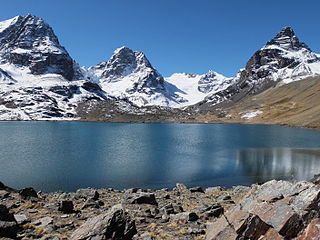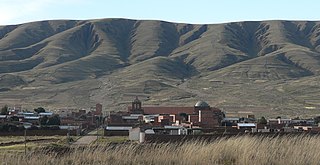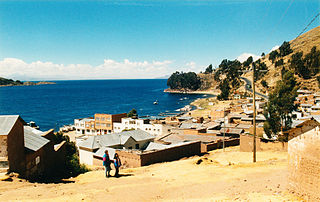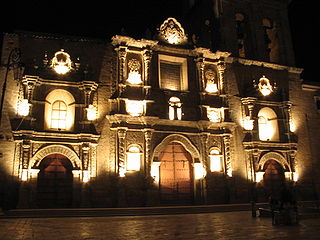
La Paz, officially known as Nuestra Señora de La Paz, is the seat of government of the Plurinational State of Bolivia. With an estimated 816,044 residents as of 2020, La Paz is the third-most populous city in Bolivia. Its metropolitan area, which is formed by La Paz, El Alto, Achocalla, Viacha, and Mecapaca makes up the second most populous urban area in Bolivia, with a population of 2.0 million, after Santa Cruz de la Sierra with a population of 2.3 million. It is also the capital of the La Paz Department.

Oruro or Uru Uru is a city in Bolivia with a population of 264,683, about halfway between La Paz and Sucre in the Altiplano, approximately 3,709 meters (12,169 ft) above sea level.

The La Paz Department of Bolivia comprises 133,985 square kilometres (51,732 sq mi) with a 2012 census population of 2,706,359 inhabitants. It is situated at the western border of Bolivia, sharing Lake Titicaca with adjacent Peru. It contains the Cordillera Real, which reaches altitudes of 6.6 kilometers (4.1 mi). Northeast of the Cordillera Real are the Yungas, the steep eastern slopes of the Andes Mountains that make the transition to the Amazon River basin to the northeast. The capital of the department is the city of La Paz and is the administrative city and seat of government/national capital of Bolivia.

Pedro Domingo Murillo is a province in the Bolivian La Paz Department. It was created on January 8, 1838, with the name Cercado and on October 17, 1912, during the presidency of Eliodoro Villazón, its name was changed in honor of Pedro Domingo Murillo, protagonist of the revolution of June 16, 1809.

Coroico is a town in Nor Yungas Province, in the La Paz Department of western Bolivia.

Calamarca or Qala Marka is the fourth municipal section of Aroma Province in the La Paz Department of Bolivia. It is located on the Altiplano and its seat is the town of Calamarca.
Collana Municipality is the seventh municipal section of the Aroma Province in the La Paz Department, Bolivia. Its seat is Collana.
Tito Yupanqui Municipality is the third municipal section of the Manco Kapac Province in the La Paz Department, Bolivia. Its seat is Tito Yupanqui.
Colquencha is a town in Aroma Province in the La Paz Department, Bolivia. It is the seat of the Colquencha Municipality.

Tiwanaku is a village in the La Paz Department, Bolivia with a population of 860 people. Towards the south of the village, there's the archaeological site of Tiwanaku.
Tito Yupanqui is a town in the La Paz Department, Bolivia. It was named after an indigenous artist, Francisco Tito Yupanqui, a 16th-century wood sculptor who sculptured a famous statue of the Blessed Virgin Mary, known as Our Lady of Candles.
San Andrés de Machaca is a town in the La Paz Department, Bolivia.
Taraco, La Paz is a town in the La Paz Department, Bolivia.

San Pedro de Tiquina is a town in the La Paz Department, Bolivia.

Coca has been cultivated in medium-altitude parts of the Bolivian Andes since at least the Inca era, primarily in the Yungas north and east of La Paz. Cultivation expanded substantially in the 1980s into the Chapare region of Cochabamba and some production flowed into the international cocaine market. The US-backed efforts to criminalize and eradicate coca as part of the War on Drugs were met by the cocalero movement's growing capacity to organize. Violence between drug police and the Bolivian armed forces on one side and the movement on the other occurred episodically between 1987 and 2003. The cocaleros became an increasingly important political force during this period, co-founding the Movement for Socialism – Political Instrument for the Sovereignty of the Peoples party. Coca growers from both the Yungas and the Chapare have advocated for policies of "social control" over coca growing, maintaining a pre-set maximum area of cultivation as an alternative to drug war policies. In 2005, cocalero union leader Evo Morales was elected president of Bolivia. Morales has pursued a combined policy of legalizing coca production in the Chapare and Yungas and eradication of the crop elsewhere.

The Witches' Market, also known as El Mercado de las Brujas and La Hechiceria, is a popular tourist attraction located in Cerro Cumbre, a mountain clearing in La Paz, Bolivia. The market is run by local witch doctors known as yatiri, who sell potions, dried frogs, medicinal plants like retama, and armadillos used in Bolivian rituals. The yatiri can be easily identified by their black hats and coca pouches containing amulets, talismans and powders that promise luck, beauty and fertility. Most famous of all the items sold in The Witches' Market are the dried llama fetuses. These llama fetuses are buried under the foundations of many Bolivian houses as a sacred offering to the goddess Pachamama.

The Museo San Francisco Cultural Center is a cultural institution located in La Paz city, Bolivia. It was established with the aim of preserving and conserving the arts and memories related to events and historic moments of the city of La Paz in Bolivia, because the history of the convent and the Basilica of San Francisco that houses the museum is closely related to the history of this city.
American Cooperative School of La Paz or ACS Calvert (ACS), is an American international school in La Paz, Bolivia, serving kindergarten through grade 12.

Ancelma Perlacios Peralta is a Bolivian cocalera activist, politician, and trade unionist who served as senator for La Paz from 2015 to 2020. Born in the rural community of Chicaloma, Perlacios ascended the ranks of women's union leadership throughout the mid-2000s and early 2010s, starting at the local and later municipal levels before reaching the national level as part of the Bartolina Sisa Confederation. Her membership there facilitated her inclusion on the Movement for Socialism's 2014 electoral list, through which she was elected to the Senate. As a legislator, Perlacios occupied a unique position in Bolivian parliamentary history as the first-ever Afro-Bolivian to serve in the Senate. She shares, together with Andrea Bonilla, the distinction of being one of the first two Afro-Bolivian women in parliament, and is one of just three overall, after Jorge Medina.












